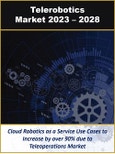Cloud Robotics as a Service Use Cases to Increase by Over 90% due to Teleoperations Market
Speak directly to the analyst to clarify any post sales queries you may have.
This report evaluates the emerging role of teleoperation and telerobotics in the era of Industry 4.0. The report analyzes the impact of teleoperation and telerobotics solutions in different industry verticals and technology sectors. Key industry verticals evaluated include education, medical, manufacturing, mining, nuclear/hazardous waste management, and transportation.
The report also provides market forecasts for IIoT, cloud robotics technologies, teleoperation, and telerobotics systems, services, and solutions. The report also evaluates the role of digital twin technology in teleoperation and telerobotics systems integration and operations.
Select Report Findings:
- North America will lead the operations and telerobotics market through 2028
- AI software in support of the teleoperations market will reach $5.9 billion globally
- Tele-maintenance solutions will grow at the highest CAGR during the forecasted period globally
- The global teleoperation and telerobotics market is poised to reach $92.6 billion by 2028
- Cloud robotics as a service use cases will increase by over 90% due to teleoperations solutions
Teleoperation represents the ability to operate equipment or a machine from a distance. A specific form of teleoperation involving remote control of a robot from a distance is referred to as telerobotics.
Key teleoperations and telerobotics systems include:
- Movement: By putting robotic arms on mobile platforms and using teleoperation to control them, robots can be used in places where they could not be used before. These new mobile applications of robots allow them to access areas that are hazardous to humans, while still performing with human-like accuracy.
- Interaction: Mobile robots need to be lightweight, compact, portable, power-dense, rugged, and efficient. These bots are designed to perform tasks as a human would in an array of difficult environments. By performing tasks once only accessible to humans, mobile robots can be implemented and automated nearly anywhere in the world.
- Analytics: Using AI and machine learning, mobile manipulators are becoming increasingly autonomous. These machines use algorithms to correct and learn over time. As mobile robotics become more efficient, they can surpass humans in terms of reliability and risk assessment/management.
- Vision Technologies: Robots need to be able to visualize and process the world around them. These mobile robots do this through LIDAR, stereo vision, and monocular vision, with sensors for both 2D and 3D imaging. Modern vision systems can locate and track a target in nearly any environment, regardless of traffic or weather.
- Advanced Communications: Teleoperation requires communication between a human and a robot. This communication needs to be extremely fast with minimal latency to achieve optimal results. 5G technologies are enabling teleoperation with lightning-fast speeds, and new solutions can be developed as a result.
Teleoperation and telerobotics are both supported by ICT infrastructure including broadband communications, sensors, machine-to-machine (M2M) communications, and various Internet of Things (IoT) technologies. The combination of teleoperations, M2M/IoT, and 5G communications will enable entirely new use cases for robotics, supported by cloud-based robotics as a service business model.
Enhancements in wireless broadband are untethering teleoperation. Prior to 5G and MobileEdge Computing (MEC), Teleoperation is largely relegated to fixed communications connections. 5G and MEC will enable Teleoperation anywhere there is 5G coverage, enabling many new consumer and industrial automation scenarios involving robotics. In particular, the publisher anticipates the realization of substantial benefits as a result of the teleoperation market embracing cloud robotics deployment in conjunction with 5G in private wireless environments.
Advanced IoT systems will also utilize digital twin technology to enable next-generation teleoperation. Digital twinning refers to the mapping of the physical world to the digital world. Coupled with haptic Internet technologies and Virtual Reality (VR), the teleoperation and telerobotics market will take a major leap as user interfaces are democratized. No longer will special equipment (often located in special locations and controlled by proprietary systems) be required for control.
In addition, cloud robotics enables teleoperation/telerobotics as a service model, allowing fractional ownership and/or usage on demand. This will greatly expand the availability and usage of machines for industrial as well as enterprise applications. As a result, many smaller companies within a given industry vertical value chain will be able to leverage telerobotics and teleoperation solutions without large capital expenditures.
With the purchase of this report at the Multi-user License or greater level, you will have access to one hour with an expert analyst who will help you link key findings in the report to the business issues you're addressing. This will need to be used within three months of purchase.
This report also includes a complimentary Excel file with data from the report for purchasers at the Site License or greater level.
Table of Contents
1. Executive Summary
Companies Mentioned
- ABB Group
- AGT Robotics
- AppFolio
- ARM Holdings
- Bosch
- Buildium
- Calvary Robotics
- Cisco
- CloudMinds
- Console
- Contiki
- Digi International
- Ekso Bionics
- Entrata
- General Electric
- H Robotics
- IBM
- Intuitive Surgical
- iRobot
- Kuka AG
- London Computer Systems
- MRI Software
- Nachi Fujikoshi
- Omron Corporation
- Property Boulevard
- RealPage
- Rockend
- TOPS Software
- Yardi Systems
Methodology

LOADING...








